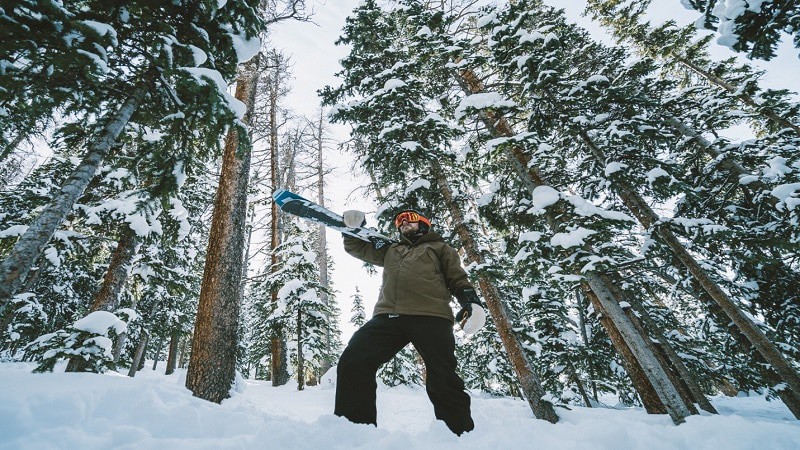Encountering bumps is certain while skiing and is arguably one of the most challenging factors associated with this sport. Bumps are made either by skiers due to the sharp turns they make while skiing or naturally because of the weather. Imagine you find a series of bumps that you fear the most while skiing, but you don’t have time to think about whether to do it or turn around towards clear a path—no surprise why skiers shy away from them. However, if you’re into skiing, you must learn how to ski bumps, as they are unavoidable.

With practice comes mastery is the best advice one could give here; however, you can start with some tips and techniques to deal with the unwanted bumps you still have to ski.
With all the information provided below, you will deliberately try to enter into a mogul field instead of stopping and telling yourself that they will throw you off balance..
How to Ski Bumps Like a Boss
Let’s start with some keys to tackling bumps.
If you want to learn how to ski bumps, you shouldn’t see them as enemies, but rather as friends and know that they not only throw you off balance but can also stop you. A bump allows you to gain support to brake before entering the turn. To understand it well, you have to arrive balanced, having control of your speed and trajectory. Initially, it is better to come slowly. You will accelerate as you master it.
There are two approaches to bumps: Unexpected and unavoidable bumps around a bend in a track that you have to ski and bump walls that you want to enter deliberately. Since you are not ready for the second approach, we’ll discuss how to deal with the first situation.
Turning around each bump requires a lot of energy and a specific technique. Therefore, when you have to negotiate a short bumpy passage, the best solution is to make long crossings. This will allow you to use a little skidding to keep control, gain too much speed and brake, and choose the place that you think is the most suitable or easy to turn. In addition, you gain ground going down diagonally. Crossings are a trick for overpassing bumpy terrain that helps a lot in skiing bumps.
Technique to adopt when arriving on the bumps
The technique requires letting oneself get on the hump and pivoting the skis once the boots are at the top of it; the poles being in a vacuum, the ski pivots quickly. Once you have turned your skis, let yourself slide down to the side: this is the start of swallowing a bump.
How to Position Yourselves for the Bumps
The bust should be straight, slightly inclined forward in relation to the plane of the slope. The head should be held high, and the gaze is drawn into the distance to anticipate the trajectory. The arms should be in front, ready to plant the poles. The knees bent, cushioning the relief.
With bust and arms in front, try to be well balanced and let your legs go up to follow the terrain. Let your skis, your knees get the top of the bump. Then, lean your chest and arms forward so that the poles pass well forward.
Beginner’s Guide
Use the top parts of the bumps for smooth sailing.
Use the primary position with your knees very bent. This position plays an essential role because they are the ones who cushion the bumps, going up like shock absorbers. This ability to cushion very rough terrain requires good muscle condition, and one must work on it. In addition, the bust must remain straight; rely on the mobility of your legs.
Exercise to Practice Skiing Bumps
When crossing a field of bumps, knees very bent, get used to cushioning the ground by letting the knees rise (flexion-extension) and keeping your torso as immobile as you can. Perform this exercise several times with gradually increasing speed and choosing increasingly steep inclines.
At the end of a crossing, choose a relatively large and round bump. Plant your pole on its top, and let the knees come up (flex) as your skis climb the hump. Once they are on it, you will have no trouble turning them. Complete the turn by descending the bump and extending to keep contact with the snow and continue crossing.
Reasonably, reduce the duration of the crossings to chain turns quickly.
How Pros do it
When you go faster and want to go down the fall line, the challenge is to keep perfect ski-snow contact. Therefore, instead of looking for the bumps’ tops, an experienced skier chooses to pass between them or on the sides, carefully choosing his path to reduce the relief.
The bust is slightly leaning forward, not very mobile and facing the slope. Only the legs do an extraordinary job of cushioning and steering the turn. The knees are flexible and can go up very high (to the chest level) in the flexion phase.
The Proper Way
Plant your stick on the bump to come, far enough away. Then drive your skis to wedge them on the slope upstream of the hump. Your legs, in the forward position, flex very firmly to absorb your speed. Therefore, the angle between your torso (facing the slope) and your skis (perpendicular to the slope) is important. During this phase of compression, take firm support on your stick.
When you pass the bump, your skis will lighten up and naturally come back in line with your torso and the slope. Your speed will then start to increase rapidly. Finally, rebalance by moving your torso forward and prepare for the next turn.
What You Should be doing
Reducing speed at times can be difficult and unforgiving while skiing. The legs are in front of the bust to prevent any forward imbalance. This does not mean that you should ski with your heels on and off your back. Remember to keep flat support on the boots’ soles and move your skis forward as the speed increases.
The stick plant is important. It needs to be planted far and quite early on the next bump. The pressure on the latter is firm, in particular, during the compression phase. The skier should look far to select his route and anticipate the turns to come while skiing.
The speed is controlled during the compression phase against the upstream face of the bump. Bent legs are absorb the shocks. Skis tackling the angle of the next hump can withstand significant pressure without the risk of skidding.
Our Final Thoughts
To wrap it up, let’s have a little recap of what we discussed above:
- Observe, anticipate and choose your path in advance.
- Stay well balanced forward.
- Be both energetic and flexible and do not stiffen.
- Use the stick plant because it helps.
The principle is to come and turn around each bump, staying well forward with a swallowing movement to stay in control. With these techniques, you won’t fear the bumps anymore but instead want to give them a try!











